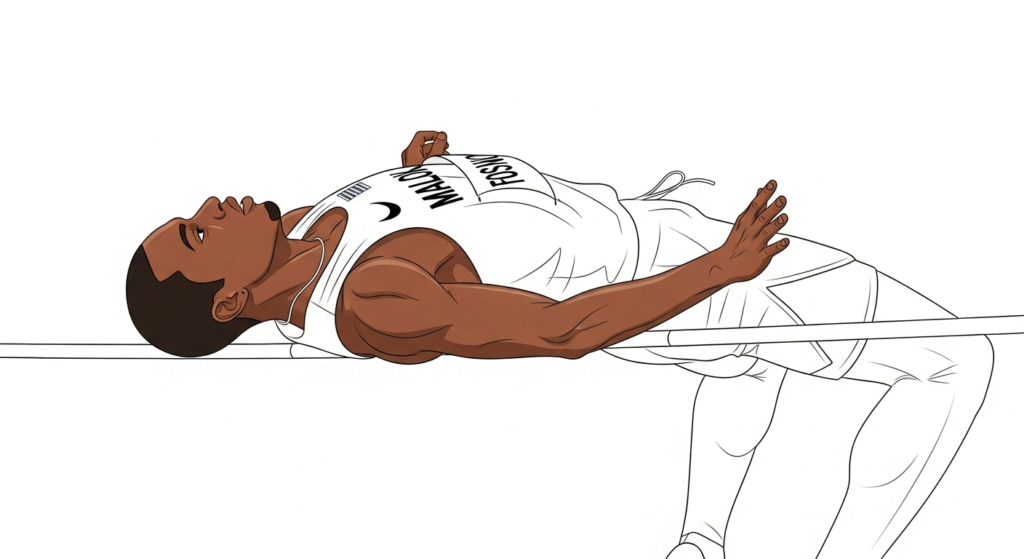High Jump Plateaus: Introduction
Every high jumper faces the dreaded wall—those frustrating high jump plateaus that halt progress and test mental fortitude. You’ve been working hard, putting in the hours, but your personal best feels out of reach. It’s not just about physical limits; it’s about smart strategy and deep understanding. This guide will help you identify why you’re stuck, provide actionable training adjustments, and equip you with the tools for consistent high jump improvement, ensuring you not only overcome high jump plateau but also regularly break PRs.

Diagnosing Stagnation: Uncovering the True Causes of Your High Jump Plateaus
The high jump journey is rarely a smooth upward curve; inevitably, every athlete encounters those frustrating high jump plateaus where progress seems to grind to a halt. This stagnation can feel like a personal challenge to your drive, a barrier to the superiority you seek, eroding confidence and the sheer enjoyment you once found in clearing new heights. But don’t despair—diagnosing these plateaus isn’t about blaming yourself; it’s about becoming a detective of your own performance, uncovering the true, often subtle, causes that are holding you back from achieving your competitive goals.
Often, the root cause isn’t a lack of effort, but a misalignment in your approach. One primary suspect is your training load. Are you pushing too hard, leading to overtraining and diminishing returns, or are you not challenging your body enough to stimulate adaptation? An imbalanced training regimen can leave you vulnerable to injuries, taking away your freedom from pain and disrupting your consistent progress. Understanding how to properly manage your workload is crucial for long-term success and vitality. For deeper insights into this critical balance, consider how to optimize your training load.
Another common culprit lies in your technique. Over time, subtle flaws can creep into your approach, takeoff, or bar clearance, becoming ingrained habits that limit your potential. These aren’t always obvious and often require a fresh pair of eyes or detailed video analysis to spot. Sometimes, a seemingly minor tweak in your approach run or a more efficient bar clearance technique can unlock significant gains, propelling you past the perceived ceiling.
Beyond the physical, psychological factors play a profound role. The pressure to perform, fear of failure, or a lack of mental focus can create formidable internal barriers. These mental blocks can prevent you from executing perfect jumps, regardless of your physical readiness. Addressing these aspects ensures a holistic approach to your training, fostering a mindset of resilience and unwavering determination, securing your peace of mind and the psychological edge needed to win. Exploring high jump psychology can provide invaluable tools to conquer these internal challenges.
Finally, don’t overlook recovery and nutrition. Your body needs adequate rest and fuel to rebuild, adapt, and grow stronger. Neglecting these fundamental elements is like trying to build a skyscraper without a solid foundation; it will inevitably lead to structural weaknesses and limit your ability to reach peak performance. Prioritizing recovery isn’t just about avoiding injury; it’s about maximizing your body’s capacity for growth and ensuring you enjoy a long, successful career.
Key Points
- High jump plateaus are common challenges, often stemming from misalignments in training rather than a lack of effort.
- Improper training load, including both overtraining and undertraining, is a significant cause of stagnation and increased injury risk.
- Subtle technical flaws in various phases of the jump can accumulate, hindering progress and requiring precise diagnosis.
- Psychological barriers such as performance pressure or fear of failure can create mental blocks that prevent physical execution.
- Adequate recovery and nutrition are fundamental for muscular adaptation, strength development, and long-term athletic vitality.
Practical Insights
- Regularly audit your training regimen and load to ensure it’s challenging enough for growth without risking injury, thereby protecting your long-term athletic vitality and success.
- Seek expert feedback or use video analysis to pinpoint subtle technical inefficiencies, transforming them into opportunities for superior performance and new personal bests.
- Implement mental training strategies to build resilience and confidence, conquering psychological hurdles and securing your peace of mind and competitive edge.
Technique Refinement: Advanced Strategies to Shatter High Jump Plateaus
The high jump journey is exhilarating, marked by triumphant clearances and the pursuit of new personal bests. Yet, every athlete eventually confronts the frustrating wall of high jump plateaus – moments where progress stalls, and heights that once felt within reach suddenly seem insurmountable. This isn’t a sign of weakness; it’s an invitation to deepen your understanding and refine your craft. To truly shatter these barriers and ascend to a superior level, we must turn our focus to the intricate nuances of advanced technique. This meticulous refinement is your secret weapon, transforming stagnation into unstoppable momentum and ensuring you not only keep up with, but surpass, your competition.
Breaking through demands an analytical eye. The first step involves rigorous video analysis, not just watching, but dissecting every frame of your jump. Are your penultimate steps consistent? Is your plant foot strike precise and powerful, setting the stage for an explosive takeoff? Many athletes overlook the subtle inefficiencies that accumulate, robbing them of vital inches. Identifying these minute flaws provides a clear roadmap, alleviating the uncertainty and fear of the unknown that often accompanies a plateau. You’ll gain peace of mind knowing exactly what needs adjustment.
Once identified, apply targeted, advanced drills designed to isolate and correct these specific weaknesses. For instance, if your approach run lacks rhythm, explore specialized mastering the high-jump approach run drills that focus solely on acceleration and curve mechanics. If your arch over the bar is inconsistent, incorporate drills that emphasize hip drive and lead leg positioning without the pressure of a full jump. This strategic approach ensures every training session is productive, building a stronger, more efficient kinetic chain that leads directly to higher clearances and a distinct competitive advantage.
Beyond individual components, consider the seamless integration of each phase. A perfectly executed approach means little without a powerful, well-timed takeoff. A flawless takeoff loses its impact without an optimal bar clearance. Focus on the transition points – the shift from the approach into the plant, the body’s rotation over the bar, and the precise timing of the kick and arm swing. Consult with experienced coaches or delve into high-jump coaching techniques to gain insights into integrating these elements fluidly. This holistic perspective allows you to move from individual excellence to a symphony of coordinated power, guaranteeing consistent progress and solidifying your status as a formidable competitor. Embrace this journey of refinement, for it is here that true champions are forged, not just reaching new heights, but owning them.
Key Points
- High jump plateaus signify a crucial opportunity for advanced technique refinement to achieve superior performance.
- Rigorous video analysis is essential for identifying subtle technical flaws in every phase of the jump, providing a clear path for improvement.
- Implementing targeted, advanced drills is key to isolating and correcting specific weaknesses, building a more efficient kinetic chain.
- Mastering the seamless integration and precise timing of all jumping phases – approach, takeoff, and bar clearance – is vital for consistent progress and higher clearances.
Practical Insights
- Regularly video record your training and competition jumps for detailed analysis, either self-guided or with a coach, to objectively pinpoint technical inefficiencies and gain peace of mind about your corrective strategies.
- Design and execute specific, isolated drills to address identified weaknesses, transforming your training into a highly efficient process that builds a clear competitive advantage.
- Practice the fluid transition between each phase of your jump, focusing on rhythm, timing, and coordination to ensure every component works in harmony for consistent and superior bar clearances.
Building the Engine: Strength & Power Training to Blast Past High Jump Plateaus
Every high jumper experiences that frustrating wall — the high jump plateau. You’re giving it your all, yet the bar seems impossibly high. This isn’t just about technique; it’s often a signal that your “engine” needs an upgrade. To truly blast past those limitations and claim your spot at the top, you must commit to building a formidable foundation of strength and explosive power. This isn’t merely about lifting weights; it’s about sculpting a body that can propel you higher, faster, and more safely than ever before, ensuring you not only clear the bar but also stand out amongst your peers. Think of it this way: raw power is the fuel for your jump, and strength is the sturdy chassis that delivers that fuel efficiently. Without a robust strength base, attempts at explosive movements become inefficient and, more dangerously, increase your risk of injury. A well-designed strength and power program targets key muscle groups vital for the high jump: glutes, hamstrings, quads, and core. Exercises like heavy squats, deadlifts, and lunges build the foundational strength necessary to generate force. But strength alone isn’t enough; you need to translate that strength into quick, powerful actions. This is where power training comes in, through plyometrics such as box jumps, hurdle hops, and medicine ball throws, along with Olympic lifts like cleans and snatches (performed under expert guidance). These movements teach your body to recruit muscle fibers rapidly, creating the explosive pop needed for takeoff. Breaking through high jump plateaus demands a strategic approach to training load and progression. It’s about smart, progressive overload, ensuring your muscles are constantly challenged to adapt and grow stronger, rather than just going through the motions. Understanding how to optimize your high jumper training load is crucial here. This intelligent progression not only enhances performance but also safeguards your body, allowing you to train consistently without the nagging fear of injury sidelining your aspirations. By focusing on building a powerful engine, you’re not just aiming for a personal best; you’re securing a future of competitive success and the sheer enjoyment of pushing your physical limits. This commitment to strength and power isn’t just about athletic gains; it’s about cultivating the discipline and resilience that defines true champions, giving you the undeniable edge you seek.
Key Points
- High jump plateaus often indicate a necessity to enhance underlying strength and explosive power.
- Developing a robust strength foundation through exercises like squats and deadlifts is crucial for generating force and preventing injury.
- Power training, incorporating plyometrics and Olympic lifts, is essential for translating raw strength into quick, explosive takeoff ability.
- A strategic and progressively challenging training load is vital for consistent improvement and injury prevention.
- Prioritizing strength and power development leads to significant competitive advantages and sustained high-level performance.
Practical Insights
- Integrate foundational strength exercises such as heavy squats and deadlifts into your regimen to build the raw power needed to blast past your current bar height, giving you a competitive edge and boosting your confidence.
- Implement explosive power training, including plyometrics (like box jumps and hurdle hops) and Olympic lifts (under proper guidance), to rapidly translate your strength into a higher, more dynamic takeoff, enabling you to outperform rivals.
- Strategically plan your training with progressive overload, ensuring your body is consistently challenged to adapt and grow stronger while minimizing injury risk, securing consistent progress and peak performance.
Coach Otto is a certified track and field coach with over 15 years of experience working with high jumpers at high school, collegiate, and elite levels.
Strategic Training Cycles: Periodization to Consistently Overcome High Jump Plateaus
Every high jumper eventually faces it: that frustrating wall, the dreaded plateau. You’ve poured in the effort, but the bar just won’t go higher. It’s disheartening, and it can erode your confidence, making you question your progress. But what if there was a strategic blueprint to consistently break through these barriers, ensuring you not only improve but do so safely and sustainably? Enter strategic training cycles, or periodization—your ultimate weapon against high jump plateaus.
Periodization isn’t just a fancy term; it’s a meticulously planned approach to training that systematically varies the intensity and volume of your workouts over time. It’s about working smarter, not just harder, to maximize your physical adaptations and peak performance when it truly matters. Imagine the sheer satisfaction of clearing a new personal best, leaving previous plateaus in your dust, knowing that every training session was purposefully designed to get you there. This structured approach is what separates consistent champions from those who burn out.
At its core, periodization organizes your training into distinct phases: macrocycles (often an entire season or year), mesocycles (shorter blocks focusing on specific attributes like strength, power, or technique), and microcycles (typically weekly plans). By intentionally manipulating these cycles, you ensure your body undergoes progressive overload, then recovers, adapts, and gets stronger without risking overtraining or injury. This systematic progression safeguards your body, offering a deep sense of security and peace of mind as you push your limits. No more guesswork, no more random workouts that lead to stagnation or, worse, injury.
This strategic planning ensures you are always building towards your peak, making incremental gains that compound over time. It allows for dedicated phases for strength development, specific technical refinement, and ultimately, peaking for competition. By understanding and implementing these cycles, you transform your high jump journey from a series of unpredictable highs and lows into a consistent ascent towards greater heights. To truly unlock your potential and elevate your high jump game, it’s essential to understand the fundamentals of this structured training; you can explore the basics of periodization for high jump here. It’s about gaining an undeniable competitive edge and the personal triumph of continuous achievement.
Key Points
- Periodization is a systematic training approach designed to break through high jump plateaus by varying intensity and volume over time.
- It organizes training into macrocycles, mesocycles, and microcycles, ensuring progressive overload, recovery, and adaptation.
- This structured planning prevents overtraining and injuries, providing a pathway to consistent improvement and peak performance.
- Implementing periodization allows athletes to consistently achieve personal bests and gain a competitive advantage.
- Understanding periodization moves athletes from random training to a purposeful, results-driven journey towards higher jumps.
Practical Insights
- Regularly video record your training and competition jumps for detailed analysis, either self-guided or with a coach, to objectively pinpoint technical inefficiencies and gain peace of mind about your corrective strategies.
- Design and execute specific, isolated drills to address identified weaknesses, transforming your training into a highly efficient process that builds a clear competitive advantage.
- Practice the fluid transition between each phase of your jump, focusing on rhythm, timing, and coordination to ensure every component works in harmony for consistent and superior bar clearances.

